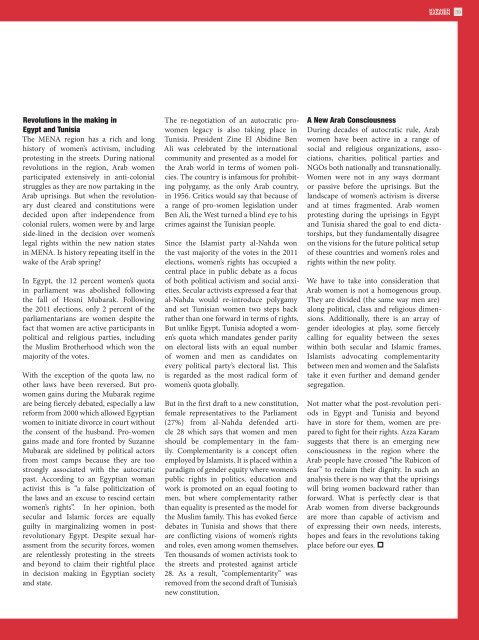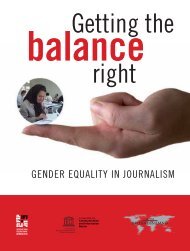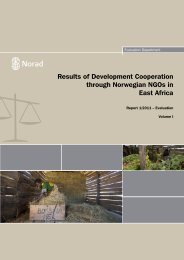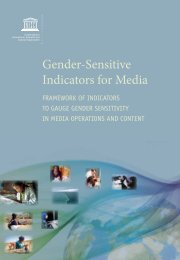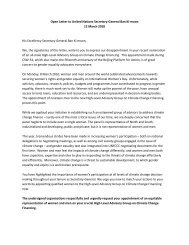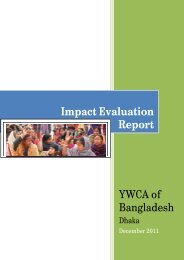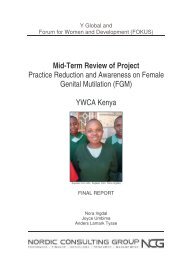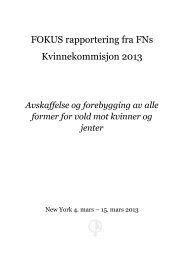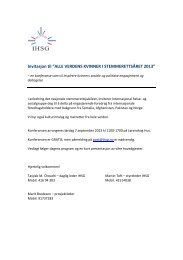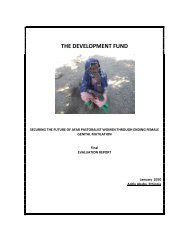Last ned PDF - Fokus
Last ned PDF - Fokus
Last ned PDF - Fokus
- No tags were found...
Create successful ePaper yourself
Turn your PDF publications into a flip-book with our unique Google optimized e-Paper software.
39Revolutions in the making inEgypt and TunisiaThe MENA region has a rich and longhistory of women’s activism, includingprotesting in the streets. During nationalrevolutions in the region, Arab womenparticipated extensively in anti-colonialstruggles as they are now partaking in theArab uprisings. But when the revolutionarydust cleared and constitutions weredecided upon after independence fromcolonial rulers, women were by and largeside-li<strong>ned</strong> in the decision over women’slegal rights within the new nation statesin MENA. Is history repeating itself in thewake of the Arab spring?In Egypt, the 12 percent women’s quotain parliament was abolished followingthe fall of Hosni Mubarak. Followingthe 2011 elections, only 2 percent of theparliamentarians are women despite thefact that women are active participants inpolitical and religious parties, includingthe Muslim Brotherhood which won themajority of the votes.With the exception of the quota law, noother laws have been reversed. But prowomengains during the Mubarak regimeare being fiercely debated, especially a lawreform from 2000 which allowed Egyptianwomen to initiate divorce in court withoutthe consent of the husband. Pro-womengains made and fore fronted by SuzanneMubarak are sideli<strong>ned</strong> by political actorsfrom most camps because they are toostrongly associated with the autocraticpast. According to an Egyptian womanactivist this is “a false politicization ofthe laws and an excuse to rescind certainwomen’s rights”. In her opinion, bothsecular and Islamic forces are equallyguilty in marginalizing women in postrevolutionaryEgypt. Despite sexual harassmentfrom the security forces, womenare relentlessly protesting in the streetsand beyond to claim their rightful placein decision making in Egyptian societyand state.The re-negotiation of an autocratic prowomenlegacy is also taking place inTunisia. President Zine El Abidine BenAli was celebrated by the internationalcommunity and presented as a model forthe Arab world in terms of women policies.The country is infamous for prohibitingpolygamy, as the only Arab country,in 1956. Critics would say that because ofa range of pro-women legislation underBen Ali, the West tur<strong>ned</strong> a blind eye to hiscrimes against the Tunisian people.Since the Islamist party al-Nahda wonthe vast majority of the votes in the 2011elections, women’s rights has occupied acentral place in public debate as a focusof both political activism and social anxieties.Secular activists expressed a fear thatal-Nahda would re-introduce polygamyand set Tunisian women two steps backrather than one forward in terms of rights.But unlike Egypt, Tunisia adopted a women’squota which mandates gender parityon electoral lists with an equal numberof women and men as candidates onevery political party’s electoral list. Thisis regarded as the most radical form ofwomen’s quota globally.But in the first draft to a new constitution,female representatives to the Parliament(27%) from al-Nahda defended article28 which says that women and menshould be complementary in the family.Complementarity is a concept oftenemployed by Islamists. It is placed within aparadigm of gender equity where women’spublic rights in politics, education andwork is promoted on an equal footing tomen, but where complementarity ratherthan equality is presented as the model forthe Muslim family. This has evoked fiercedebates in Tunisia and shows that thereare conflicting visions of women’s rightsand roles, even among women themselves.Ten thousands of women activists took tothe streets and protested against article28. As a result, “complementarity” wasremoved from the second draft of Tunisia’snew constitution.A New Arab ConsciousnessDuring decades of autocratic rule, Arabwomen have been active in a range ofsocial and religious organizations, associations,charities, political parties andNGOs both nationally and transnationally.Women were not in any ways dormantor passive before the uprisings. But thelandscape of women’s activism is diverseand at times fragmented. Arab womenprotesting during the uprisings in Egyptand Tunisia shared the goal to end dictatorships,but they fundamentally disagreeon the visions for the future political setupof these countries and women’s roles andrights within the new polity.We have to take into consideration thatArab women is not a homogenous group.They are divided (the same way men are)along political, class and religious dimensions.Additionally, there is an array ofgender ideologies at play, some fiercelycalling for equality between the sexeswithin both secular and Islamic frames,Islamists advocating complementaritybetween men and women and the Salafiststake it even further and demand gendersegregation.Not matter what the post-revolution periodsin Egypt and Tunisia and beyondhave in store for them, women are preparedto fight for their rights. Azza Karamsuggests that there is an emerging newconsciousness in the region where theArab people have crossed “the Rubicon offear” to reclaim their dignity. In such ananalysis there is no way that the uprisingswill bring women backward rather thanforward. What is perfectly clear is thatArab women from diverse backgroundsare more than capable of activism andof expressing their own needs, interests,hopes and fears in the revolutions takingplace before our eyes.


